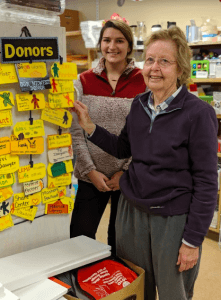
Dec 13, 2018 | Feature |

Mary Ryan, pictured with student worker Brooke Carrier, educates the community about recycling. (Photo by Andrea Swiedom)
Contributing Writer
In the basement of the Education Center, a room is shelved with items for sale that people would commonly call trash– an assortment of leather scraps, salvaged coffee cans, jars of colorful buttons, used spools of Christmas ribbon. For thirty-eight years, Depot Coordinator Mary Ryan has been collecting reusable items destined for incineration or a landfill for the non-profit organization, Everyone’s Resource Depot (ERD).
Ryan, who is originally from Wilton, had been teaching high school biology in Massachusetts when ERD was founded in 1979 by UMF faculty. A year later, Ryan returned home to take some time off from teaching. When she learned about ERD, she was immediately compelled to join the organization.
Ryan associated her interest in reusing from her mother who did a lot of crafts and utilized items around the house rather than going to the store to buy materials. “So I think that was probably a big part of what interested me, but also just the idea that we just throw so much stuff away,” said Ryan.
The depot accepts donations and keeps a running list of wanted items posted on the wall and on the depot’s website. Ryan is currently on the look-out for pom poms, baby food jars and coffee filters, to name a few. Sometimes, Ryan has to reject donations, but she always provides guidance as to how people can recycle what they’ve brought in. However, when Ryan first started at ERD, Farmington didn’t have a recycling center.
“There wasn’t anywhere near the emphasis back in 1980 on recycling or reusing. There was no community recycling then either,” said Ryan. “This has all happened since so, I guess the world was very different in a way.”
Ryan’s efforts to minimize trash did not stop with ERD. She set out with a community group to successfully establish Farmington’s recycling center. “So now we can say to someone who brings us a bag of stuff, ‘now these particular things can go into your recycling.’ They might not really keep track of what they can recycle,” Ryan said while running her hand through a container of buttons.
The Depot is a tactile experience as much as a shopping experience with boxes full of felt, wood pieces organized by shape and beads organized by color. It’s difficult to refrain from impulsively touching everything. While individual donations contribute to the variety of items, so does relationships with local businesses that Ryan and board members have formed over the years.
WA Mitchell Fine Furniture started donating wood scraps and dowels three years ago and Ryan picks up plastic fish tubs from Moser’s Seafood every month. Once items make it to the depot, student workers play a huge role in organizing the plethora of donations. Ryan expressed immense gratitude towards her student workers who often organize items in ways she wouldn’t consider and it often helps keep items moving.
“I appreciate [student workers]…looking at something with a different eye because you get so used to something, you just accept that that’s the way it’s going to be,” said Ryan. Keeping items moving is integral to this organization which currently has a storage room stuffed to the brim with items that haven’t sold.
Ryan said she’d like to see more students utilize the ERD and ask themselves, “‘what could I use here [at ERD] and do I need that particular item that I was just gonna go to Wal-Mart for, or is there something else here that would work just as well?’”
The pricing at ERD ranges from five cents to two dollars per individual item so customers can buy the exact amount they need. There are similar organizations to ERD in Lewiston and Westbrook, but their pricing is based on a yearly membership fee which can pose as a barrier for a person to just walk in and grab what they need for a single project. Ryan prefers ERD’s open to the public, pay per item set-up. “I just think people think more about what they’re picking up…if they’re paying for it. It’s just human nature.”
Everyone’s Resource Depot is located in room 009 in the Education Center. Visit resourcedepot.umf.maine.edu for more information.
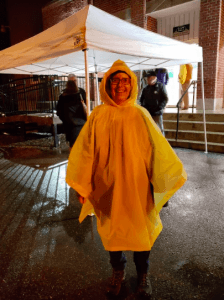
Nov 26, 2018 | Feature |
By Andrea Swiedom Contributing Writer
On election day, students saw Farmington

Professor Sarah Hardy in her “emergency voter suppression” poncho (Photo by Andrea Swiedom)
community member Bill Crandall, who set up a sign outside of the polls at the Farmington Community Center. Given Crandall’s professional setup, there has been controversy as to whether Crandall was posing as a poll official to intimidate young, first-time voters.
Crandall was bundled up and prepared for his self-imposed, all-day shift to inform the public about the laws outlined in the last paragraph of the Maine Voting Residence Fact Sheet on the maine.gov website. Even the professionally-made sign that displayed these laws had protection against the rain beneath a pop-up tent that faced the direction of High Street rather than the community center’s entrance on Middle Street.
Crandall was acting independently by presenting information about the responsibilities that follow registering to vote in Maine which include registering a vehicle within 30 days and potentially being subject to Maine income tax. Crandall did not include a single quote from the section of the voting fact sheet entitled “Students,” which clarifies the often confusing status of a student’s residency when attending an out-of-state university.
Students walking from campus often took High Street to get to the polls. For freshman Grace McIntosh and her friends, Crandall was their first impression of the community center when they walked from Mallett Hall.
McIntosh attended high school with Crandall’s son. “[I assumed Crandall was] someone who was helping out with the voting process, possibly that he was answering questions on what to do for first-time voters,” McIntosh said through an email.
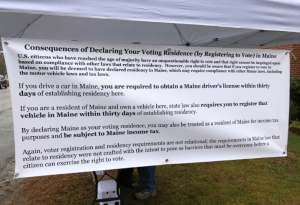
Bill Crandall’s sign outside the Farmington Community Center (Photo by Andrea Swiedom)
To mathematics professor Sarah Hardy, the way in which Crandall presented these laws was “a little bit out of context.” Hardy is no stranger to voting rights activism and petitioned against the 2011 bill to appeal same day voting registration in Maine. When Hardy learned about Crandall’s sign from a long threaded email sent by concerned community members, her voter suppression alarm bells started ringing.
Hardy quickly brushed up on Maine voting laws and then set out with a bright yellow poncho determined to stick out the rest of the stormy day by standing right next to Crandall to ensure students were not intimidated to vote.
By the time Hardy arrived around 4 p.m., emails had already been sent out to faculty and students describing the sign as “misleading.” Despite Hardy’s presence at the polls and campus emails, the sign did cause at least one student to feel unraveled according to the president of UMF’s College Democrats Club, Jeffrey Willey, who spent election day in the student center reminding students how and where to vote.
Willey said, “One girl came up to me, she was like, pretty shaken…because she had convinced her friend to vote that morning and to go and register.” Willey explained that after she learned about the laws Crandall was presenting them, she was worried “that she had convinced her friend to break the law and that he was gonna go to jail and something serious like that.”
Crandall is willing to articulate his motives to The Farmington Flyer after he meets with interim president Eric Brown. Crandall said he feels like the situation was “blown out of proportion.”
Meanwhile, several community and faculty members feel as though Crandall’s efforts on election day were targeted towards deterring students from casting a ballot. As Hardy put it, with a stone-cold straight face, “Don’t mess with my students.”
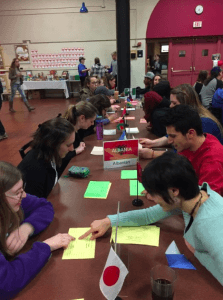
Nov 8, 2018 | News |
By Andrea Swiedom Contributing Writer
The Global Education Offic

Speed Language is an activity that allows participants to quickly learn phrases and words from other languages. (Photo courtesy of Lynne Eustis)
e at UMF will be hosting a series of events for International Education Week from Nov. 13th to 17th to raise awareness about different cultures, many of which are represented by students and faculty. Activities will incorporate regional foods and beverages, languages and crafts.
While the goal for the week is to educate students about different customs and parts of the world, it will also provide a space for exchange students. “They’re not just here to take classes,” said Lynne Eustis, assistant director of Global Education. “They should be able to share information about their culture.”
Asako Miyazaki, a visiting Japanese professor who will be involved in the language and food- themed day, said, “I want students to be more…more active so they can understand how their culture is different from each other, but also how we can share the culture itself.” Miyazaki went silent a moment to formulate this thought. “And I think, we don’t have to compare, we can just share and enjoy the time.”
To kick-off the week, there will be a presentation Tuesday evening at 6 p.m. in the Fusion Space, run by UMF alumna, Elizabeth Ferry. The presentation will cover her time in Tanzania working in the peace corps.
On Wednesday, during common time, there will be a Francophone event to educate participants about French language, food and culture.
Thursday will offer two opportunities open to the Farmington community. One event is the International Bazaar which will take place in The Landing from 4 p.m. to 6 p.m. This is where items acquired through international travel will be sold to benefit the Global Education travel fund. Eustis hopes to see attendees at the Bazaar funnel into the other event, which will feature international foods and quick language lessons from 4 p.m. to 7 p.m. in the Dining Hall.
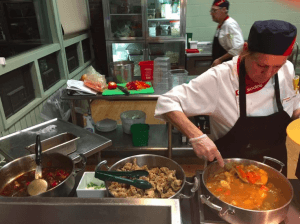
Sodexo staff working hard to cook traditional recipes submitted by exchange students form around the world. (Photo courtesy of Lynn Eustis)
Students who are native speakers of Swahili, French, Japanese, Chinese, Albanian and Spanish will conduct speed language segments. “It’s kinda like speed dating, but its speed language!” said Eustis with a beaming smile. Participants will spend four minutes with a native speaker learning basic phrases before rotating.
While speed language is taking place, there will also be an opportunity to try a spread of traditional foods from Argentina, Tanzania and Japan. Students from these countries have submitted recipe proposals to Sodexo and their staff will select one dish from each country to prepare alongside the typical dinner menu, at no additional cost.
Flor Villarreal, Spanish language teaching assistant from Argentina, submitted empanadas which are savory pastries filled with meat or vegetables and panqueques con dulce de leche which are similar to crepes that are rolled up with a rich caramel sauce.
Just talking about the food from Argentina made Villarreal’s face light up. “We eat dulce de leche with everything, I mean we can have it for breakfast, as dessert, we can just eat it with a spoon!”
Miyazaki submitted recipe proposals as well, which included a s

Flags from all countries are hung in the dining hall to celebrate International Education Week. (Photo courtesy of Lynn Eustis)
avory pancake called Okonomiyaki, proving to be a language lesson in and of itself. “Actually Okonomiyaki means, what do you want? Or, what do you like?” explained Miyazaki. The dish allows the cook to add in any vegetable, meat or seasoning into the batter before grilling the pancake.
Finally, on Friday, an International Tea and Coffee Hour will take place from 12 p.m. to 1 p.m. in the Fusion space.
Eustis is still planning more events for the International Education Week and will be posting more information about scheduled events and their locations on MyCampus and on bulletin boards throughout campus.

Oct 25, 2018 | Feature |
By Andrea Swiedom Contributing Writer
Countless times I have made the mistake of asking seniors what their plan is after they graduate. Usually there’s an eyeroll and a sarcastic remark like, “Oh, I love that question.” So here’s an idea for those who are unsure what comes after UMF: an all-expenses paid year abroad.

Riding Horses was Sarah Gould’s favorite pastime in Mongolia (Photo courtesy of Sarah Gould)
Recently, Professor Anne Marie Wolf, UMF’s Fulbright Program Adviser, presented information on the Fulbright Award. This postgraduate opportunity is available to baccalaureates up until they receive their doctorate to teach English or conduct independent research abroad for nine to twelve months. Awardees are provided a living stipend, a roundtrip ticket, medical insurance and in some cases, funding to attend a masters program.
The Fulbright looks prestigious on resumes and graduate school applications, but according to Wolf, the major benefit is, “You get to live in another culture and learn y’know, how other people see us, see life, how they kind of go about their daily lives.”
Sarah Gould, a UMF alumna, was a 2017 Fulbright teaching assistant in Ulaanbaatar, Mongolia. She spent the 20 required hours a week co-teaching English in classrooms at the National University of Mongolia. Gould also pursued extracurricular activities such as riding horses in the Mongolian Steppe and taking a sunset camel ride in the Gobi desert.
While she expressed cultural and climate shock– temperatures in Mongolia can reach -45 degrees C. “Stepping off the plane in Boston [upon returning], I was flooded with this feeling that I had accomplished a challenge that during the year seemed impossible,” said Gould in an email.
This may be one of the most influential side effects from the Fulbright–the scope of impossibility narrows. Gould is now pursuing a degree in International Migration with a specialization in Human Rights Law at the Brussels School of International Studies.
The research award requires applicants to pose a question that they plan to investigate an answer to while abroad. This is not as intimidating as it sounds since the proposal is a mere two pages.
“They don’t expect these projects to produce groundbreaking research that saves humanity,” said Wolf. “But they want you to have some kind of goal and curiosity that you’ll be pursuing over there.”
Although the number of annual UMF applicants is usually no higher than three, the university has an impressive acceptance rate. There have been seven students in the past four years who have received the award to countries such as Spain and Thailand. Despite these promising numbers, only three people,myself included, showed up to Wolf’s Fulbright presentation.
Perhaps students automatically assume they are underqualified, but as Wolf adapted to our small group and perched herself on a table close to us, she spoke candidly about the award’s misperceptions. The teaching assistant award does not require applicants to be education majors, they just need to demonstrate some inclination towards teaching such as tutoring.
Nor does the Fulbright require a 4.0 GPA. Wolf explained that applicants just need to show good academic standing. This reminded me of my Spanish professor, Steven Wenz, who has expressed his regret for not applying for the Fulbright before going into a doctorate program. The stereotypes associated with the award prevented Wenz from ever trying. “I saw it as something almost mythic…like somehow you had to be a genius to get a Fulbright,” said Wenz.
By the end of Wolf’s presentation, I was convinced more students at UMF could successfully apply for a Fulbright Award. Don’t feel as though this opportunity is out of reach. Besides, it’s a lot more fun feeling freaked out about your future in a foreign country.
Contact Professor Anne Marie Wolf at anne.marie.wolf@maine.edu for more information.

Oct 11, 2018 | News |
By Andrea Swiedom Contributing Writer
Dale Rappaneau and Emily Marquis, the two editors in charge of this year’s Sandy River Review, are on a mission to promote art and writing submissions from all UMF students for the 39th v

Dale Rappananeau and Emily Marquis are this year’s Sandy River Review Editors. (Photo courtesy of Andrea Swiedom)
olume.
Creative Writing majors at UMF are often reminded by their professors to submit to The Sandy River, but there has been little to no outreach to promote submissions amongst the rest of the students on campus.
The Sandy River Literary Journal was established in 1982 and is published once a year by two of UMF’s Creative Writing interns. Though the journal is overseen by Alice James Books, the interns have complete control over submissions.
“We don’t just publish UMF work. Right now, we have submissions from Hawaii, one from the Netherlands and one from Arkansas,” said Rappaneau.
Marquis expressed the desire for Sandy River editors to be more visible so that they can encourage all students, regardless of their major, to submit their work. “That’s why we set up the table in the student center trying to get submissions from people who aren’t creative writing majors who still like to write,” said Marquis.
Not only are the editors looking for a broader pool of UMF students to choose work from, but they are also hoping to see a diverse spread of genres.
A genre the editors would like to see is one that explores the self. “We were talking about how maybe we would want to break [The Sandy River] into sections like, personal or family-wise or community-wise and break up the pieces according to that,” explained Marquis.
Rappaneau expressed his desire to see more science-fiction and fantasy submissions. “I don’t think we could turn the magazine into strictly dystopian sci-fi all of a sudden,” said Rappaneau. He hopes his selection process for the journal will showcase genres that haven’t been represented in past anthologies.
As long as the editors uphold The Sandy River’s tradition of showcasing contemporary writing, they have the freedom to design the journal however they want, within reason.
The editors are also hoping to see a large variety of art mediums submitted to the journal this year. “Previously they [former editors] would accept photography, art, mixed media. We would like to see a lot of illustrations in this anthology,” said Rappaneau.
Adding illustrations will help make this anthology stand out from past volumes, but so will the vision for the cover design. The editors are holding a contest exclusively for UMF students to submit their art work for this volume’s cover.
To make the submission process less nerve-wrecking, students can attend the Writer’s Guild, a writing club that meets on Mondays at 7 p.m. on the third floor of the Creative Writing House. When attended regularly, the club is an ideal place to prepare pieces for submission.
Annie Moloney, who is currently the Writing Guild President, initially had her work rejected for the The Sandy River, but she received a letter from the editor encouraging her to continue working on the piece and to re-submit it.
“I brought it to Guild and I had a really good workshop there,” said Moloney, “and I eventually kind of changed the format of it from a piece of flash fiction into a monologue which was my first experience writing dramatic work.” Moloney re-submitted her edited piece, “Until It Does,” and had it published in the 36th volume of the literary journal.
The Sandy River is accepting art and writing submissions until Dec. 7 and the 39th volume will be published in May 2019. Submission guidelines can be found online at https://sandyriverreview.com.








